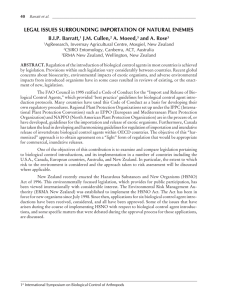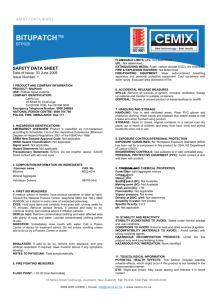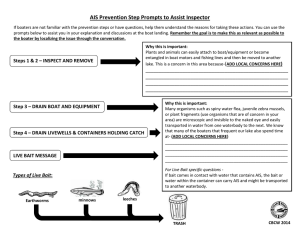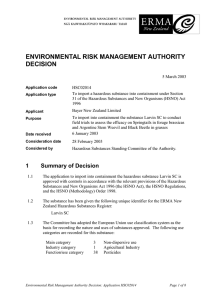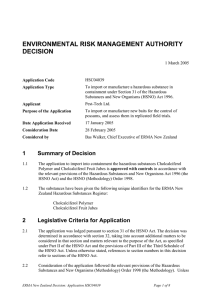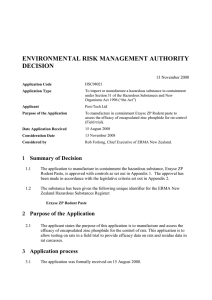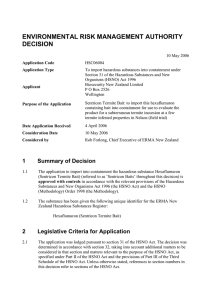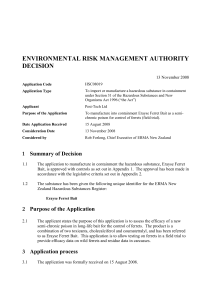ENVIRONMENTAL RISK MANAGEMENT AUTHORITY DECISION
advertisement
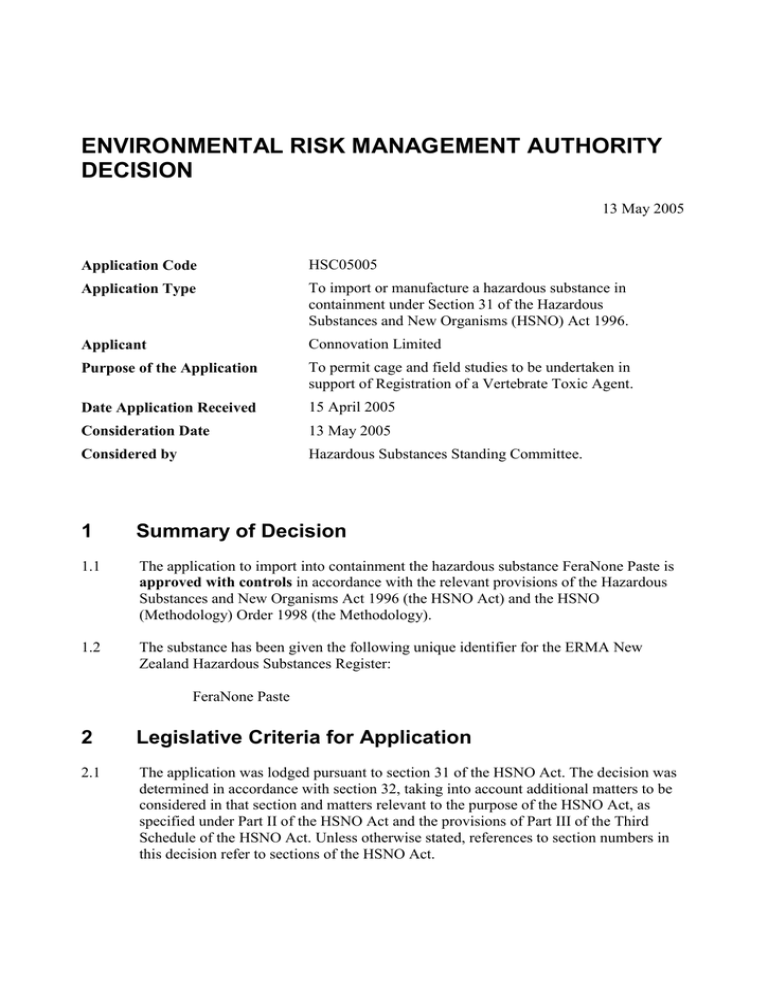
ENVIRONMENTAL RISK MANAGEMENT AUTHORITY DECISION 13 May 2005 Application Code HSC05005 Application Type To import or manufacture a hazardous substance in containment under Section 31 of the Hazardous Substances and New Organisms (HSNO) Act 1996. Applicant Connovation Limited Purpose of the Application To permit cage and field studies to be undertaken in support of Registration of a Vertebrate Toxic Agent. Date Application Received 15 April 2005 Consideration Date 13 May 2005 Considered by Hazardous Substances Standing Committee. 1 Summary of Decision 1.1 The application to import into containment the hazardous substance FeraNone Paste is approved with controls in accordance with the relevant provisions of the Hazardous Substances and New Organisms Act 1996 (the HSNO Act) and the HSNO (Methodology) Order 1998 (the Methodology). 1.2 The substance has been given the following unique identifier for the ERMA New Zealand Hazardous Substances Register: FeraNone Paste 2 Legislative Criteria for Application 2.1 The application was lodged pursuant to section 31 of the HSNO Act. The decision was determined in accordance with section 32, taking into account additional matters to be considered in that section and matters relevant to the purpose of the HSNO Act, as specified under Part II of the HSNO Act and the provisions of Part III of the Third Schedule of the HSNO Act. Unless otherwise stated, references to section numbers in this decision refer to sections of the HSNO Act. 2.2 Consideration of the application followed the relevant provisions of the Methodology. Unless otherwise stated, references to clauses in this decision refer to clauses of the Methodology. 3 Application Process 3.1 The application was formally received on 15 April 2005 and assessed as having sufficient information to proceed. 3.2 Project Team: Nicola Reeves Advisor (Hazardous Substances) Sue Scobie Senior Advisor (Hazardous Substances) Zack Bishara Māori Policy Advisor Report review and sign-out by: Beth Dye Applications Manager (Hazardous Substances) 3.3 The applicant supplied the following documents: The application Confidential appendices. 3.4 The following Government departments were advised of the receipt of the application (in accordance with clause 2(2)(e)) and given the opportunity to comment: The Ministry of Health The Department of Labour (Occupational Safety and Health) The Agricultural Compounds and Veterinary Medicines (ACVM) Group of the New Zealand Food Safety Authority. The Department of Conservation. 3.5 No comments were received. 3.6 The applicant was provided with a copy of the proposed controls for FeraNone Paste and given the opportunity to comment on them. No comments were received. 4 Consideration Sequence of the Consideration 4.1 The following members, drawn from the Hazardous Substances Standing Committee, considered the application (section 19(2)(b)): Mr Tony Haggerty, and Professor George Clark. 4.2 In accordance with section 32 of the HSNO Act, the approach adopted when considering this application was to confirm whether the application was for one of the purposes specified in section 30, to identify and assess the risks and to determine ERMA New Zealand Decision: Application HSC05005 Page 2 of 10 whether the substance could be adequately contained by controls to provide for each of the matters specified in Part III of the Third Schedule of the HSNO Act. Purpose of the Application 4.3 The purpose of the application is to permit cage and field studies to be undertaken in support of registration of a Vertebrate Toxic Agent. 4.4 As the purpose amounts to “research and development on any hazardous substance to acquire information for use in assessing that substance for a HSNO approval”, the Committee considers that the application qualifies for consideration under section 30(ba) of the HSNO Act. Life Cycle 4.5 Connovation Limited plan to manufacture FeraNone Paste in small batch sizes in their premises in East Tamaki, Auckland. 4.6 The poison component of the substance will be stored under lock and key in accordance with Good Manufacturing Practice. Dispensing and addition of the poison to the batches will be done under supervision. The active poison ingredients of the bait will be controlled under Connovation Limited’s Quality Assurance System during the preparation of the bait. 4.7 The bulk batches will be packaged in 20 kg plastic pails which will be labelled and have tamper proof lids. The pails will be stacked onto pallets, wrapped and labelled. Transport of the substance to trial sites will be by dangerous goods courier and appropriate documentation will accompany the substance. Once at the trial sites the bait will be stored in the dangerous goods stores of Environment Bay of Plenty and Timberlands West Coast, until required for use. 4.8 Cage trials will be undertaken by Woodville Animal Test Facility. Additionally two field trial sites will used: one in the Bay of Plenty and one on the West Coast of the South Island. 4.9 At the Bay of Plenty trial site 140 Philproof bait stations will be used in a 600 metre by 600 metre area. Each station will be loaded with 550 g of FeraNone Paste and replenished weekly, with residual bait being removed each time. Baiting will continue until bait ceases to be eaten from the station. 4.10 At the West Coast trial site the bait will also be presented in Philproof bait stations. A total of 180 stations each loaded with 200 g of Feranone paste will be used. Bait will be replenished on a weekly basis, with residual bait being removed from the stations. Baiting will continue until bait ceases to be eaten from the station. 4.11 Philproof bait stations are the industry standard and are designed to exclude non-target organisms such as birds and domestic animals. ERMA New Zealand Decision: Application HSC05005 Page 3 of 10 4.12 Any residual bait removed from the trial sites and any unused bait will be returned to Connovation Limited for disposal. Disposal of the substance will be carried out by Nuplex Environmental Limited. Hazardous Properties 4.13 The Committee notes that a containment application only requires sufficient understanding of the hazardous properties to ensure that any risks can be managed by the containment controls. 4.14 The Committee has assessed the available information and notes that diphacinone is an anticoagulant, and is highly toxic to humans via oral, inhalation and dermal routes. The applicant indicates that care must be taken when handling the bait and appropriate protective clothing will be worn when dispensing and mixing the bait. 4.15 The applicant indicates that FeraNone Paste contains a very low quantity of active ingredient and therefore the quantity of active ingredient that the environment will be exposed to will be low. Diphacinone is considered toxic to aquatic organisms; however it rapidly decomposes in water and in sunlight. Diphacinone is an anticoagulant, which is toxic to mammals; as a result the bait poses a risk to non-target mammalian species. Additionally, diphacinone is toxic to birds. 4.16 The Committee has reviewed the applicant’s hazard information and consider that it is sufficient to describe the hazards associated with the substance to ensure that any risks can be managed by the containment controls. Identification and Evaluation of the Significant Risks of the Substance in Containment 4.17 In accordance with sections 5, 6, and 8 and clauses 9 and 11, the Committee considered the potential risks of escape from containment under the headings of environmental, human health and welfare and Māori issues and concerns. 4.18 In the application, the applicant identified and assessed potential risks, and detailed proposals for, and impacts of risk management. The Committee has reviewed the applicant’s assessment of the risks and agree that it is suitable for the consideration below. Risks to the Environment 4.19 If released into waterways, the substance has the potential to result in adverse effects on aquatic organisms. Additionally the baits are toxic to mammalian and bird species, and therefore, there is a risk that toxicity to non-target species may occur. 4.20 On the basis of the lifecycle of the substance outlined in paragraphs 4.5 to 4.12, adverse effects could arise from: An accident during transportation, storage, or use resulting in release of the substance Failure to follow correct disposal procedures, as outlined by the applicant. ERMA New Zealand Decision: Application HSC05005 Page 4 of 10 4.21 The Committee considers that, taking into account the application of these baits using bait stations, the storage controls in Appendix 1, the provision made for the disposal of remaining substance, the rapid decomposition of the toxicant and the Approved Handler requirements, there are no significant risks to the environment. Risks to Human Health and Welfare 4.22 If the substance is ingested, inhaled or comes into contact with skin, there is the potential for adverse effects on human health to occur. 4.23 On the basis of the lifecycle of the substance outlined in paragraphs 4.5 to 4.12, adverse effects could arise from: An accident during transportation, storage, or use resulting in exposure to the substance Failure to follow correct disposal procedures, as outlined by the applicant. 4.24 The Committee considers that, taking into account the restricted access to the field trial site, the packing and storage controls in Appendix 1, the provision made for the disposal of remaining substance, the requirement to wear chemical resistant gloves when handling the baits and the Approved Handler requirements, there are no significant risks to human health and welfare. Māori issues and concerns 4.25 The Committee considered the potential Māori cultural effects of this application in accordance with sections 6(d) and 8 of the HSNO Act, and the assessment framework contained in the ERMA New Zealand User Guide “Working with Māori under the HSNO Act 1996”. 4.26 If the substance was released into the environment, it is likely to have an adverse effect on non-target terrestrial vertebrate species, including native species, and therefore to the mauri of those ecosystems. However, standard and suggested controls proposed for the trial will mitigate the risk of unintended release to negligible levels. 4.27 From the information provided, and considering that the application is for a containment trial, the Committee considers that it is unlikely to have an impact on the relationship between Māori culture and their traditions with their ancestral lands, water, sites, waahi tapu, valued flora and fauna and other taonga. This is on the condition that the substance is used in accordance with the HSNO controls established for this application, and in accordance with any other relevant controls applying under other legislation. 4.28 In addition, the trial of this substance does not involve significant community exposure or significant exposure to the environment, so the Committee considers that there is no requirement for the applicant to consult with Māori regarding this application. 4.29 However, should inappropriate or accidental use, transport or disposal of the substance result in the contamination of waterways, it is suggested that the applicant notify the appropriate authorities including the relevant iwi authorities in the region. ERMA New Zealand Decision: Application HSC05005 Page 5 of 10 This action should include advising them of the contamination and the measures taken in response. 5 Containment and Controls 5.1 The Committee has evaluated the adequacy of the containment arrangements proposed by the applicant and the controls listed in Appendix 1, and notes that these cover the matters set out in Part III of the Third Schedule of the Act, being To limit the likelihood of escape of any contained hazardous substances or contamination by hazardous substances (for example, controls 14) To exclude organisms from a facility (for example, control 3) To exclude unauthorized people from the facility (for example, control 11) To prevent unintended release of the substances by experimenters working with the substance (for example, control 3) To control the effects of any accidental release of the substance (for example, control 16) Inspection and monitoring requirements (for example, control 23) Qualifications required of the person responsible for implementing the controls (for example, control 19) 5.2 The Committee is satisfied that with adherence to the controls listed in Appendix 1 and those controls in place under other legislation, FeraNone Paste can be adequately contained. 6 Decision 6.1 The Committee has considered this application under section 31 to import into containment hazardous substances, and pursuant to section 32, the Committee is satisfied that this application is for the purpose specified in section 30(ba). 6.2 Having considered the risks associated with the lifecycle of FeraNone Paste, the Committee is satisfied that the controls imposed, including those in place under other legislation, will result in the substance being adequately contained. 6.3 In accordance with clause 36(2)(b) of the Methodology the Committee records that, in reaching this conclusion, the Committee has applied the criteria specified in section 32 of the Act. 6.4 The Committee has also applied the following criteria in the Methodology: clause 9 – equivalent of sections 5, 6 and 8; clause 11 – characteristics of substances; clause 21 – the decision accords with the requirements of the Act and regulations; clause 22 – the evaluation of risks – relevant considerations; clause 24 – the use of recognised risk identification, assessment, evaluation and management techniques. ERMA New Zealand Decision: Application HSC05005 Page 6 of 10 6.5 The application to import into containment the hazardous substance FeraNone Paste is thus approved pursuant to section 32 of the Act, with controls as set out in Appendix 1. signed Tony Haggerty Date 13 May 2005 Chair Hazardous Substances Committee ERMA New Zealand Approval Code: FeraNone Paste: HSC000154 ERMA New Zealand Decision: Application HSC05005 Page 7 of 10 Appendix 1: List of controls that apply to the hazardous substance FeraNone Paste 1. The trials shall be conducted only for the purposes stated in the application and shall be undertaken in accordance with the study plans supplied to ERMA New Zealand. Modifications to the proposed trials may be approved in writing by ERMA New Zealand providing that they comply with the following controls. 2. Notwithstanding the requirements of control 1 above, the trials shall also comply with the following controls: 3. Manufacture of FeraNone Paste shall be limited to Connovation Limited’s premises in East Tamaki, Auckland. Once manufactured, bait stored at the premises shall be stored in a locked storeroom. 4. Prior to manufacture of the baits, all toxicants shall be stored under lock and key. 5. Access to the locked stores shall be restricted to approved personnel. 6. While in storage and during transport the baits shall be securely packed in suitable containers that comply with the Hazardous Substances (Packaging) Regulations 2001, and shall be labelled in accordance with the Hazardous Substances (Identification) Regulations 2001. Information on appropriate safety precautions necessary to provide safeguards against the substance’s toxic and ecotoxic properties shall accompany the substance. 7. Transport shall be by dangerous goods courier only. 8. The field trials shall only be undertaken at the properties identified in the management plan as the trial sites. The cage studies shall be undertaken at Woodville Animal Testing Facility. 9. Caged studies shall only be conducted on rodents. Unwanted carcasses from the caged study shall be disposed of by incineration. Remaining bait from this study shall be returned to Connovation Limited, where it shall be kept under lock and key until subsequently disposed of by Nuplex Environmental Limited. 10. When not in use, bait shall be stored in the locked dangerous goods stores of Environment Bay of Plenty and Timberlands West Coast until loaded into bait stations, or under lock and key at Woodville Animal Testing Facility. 11. Access to the field and cage trial sites area shall be restricted to authorised persons only for the duration of the trials. 12. Landowners in adjoining properties to the field trial sites shall be contacted in person and informed in writing of the field trial. The information supplied to these landowners shall include a description of the field trials, warnings of the risks to livestock, domestic animals and children who may trespass on the trial site, and the dates on which the bait will be applied to, and removed from, the trial site. ERMA New Zealand Decision: Application HSC05005 Page 8 of 10 13. For the duration of the trial while bait is present in the field trial sites, warning signs shall be placed at each entrance. 14. The substance shall only be used in bait stations at the field trial sites. The stations used shall be designed to prevent access to the bait by birds and other non-target species. 15. At the end of field trial remaining bait shall be removed from the bait stations and returned to Connovation Limited’s premises in Auckland, where it shall be kept under lock and key until subsequently disposed of by Nuplex Environmental Limited. 16. Any accidental spillage of the substance shall be contained, and placed in an appropriate container. These containers shall be returned to Connovation Limited for disposal. 17. Persons manufacturing and handling the bait shall wear chemical resistant gloves. 18. The location and movement of FeraNone Paste shall be recorded at each stage of its lifecycle. 19. Persons applying the bait in the field studies shall hold an Approved Handler qualification. However, the baits may be applied by a person who is not an approved handler if: an approved handler is present at the facility where the baits are being handled, and the approved handler has provided guidance to the person in respect of handling, and the approved handler is available at all times to provide assistance if necessary. 20. The manufactured bait shall not be offered for sale. 21. Occupational Safety & Health, Head Office [Attn. HSNO Project Manager (OSH) or equivalent position] and ERMA New Zealand shall be informed in writing (by letter, fax or email) of the start and completion of the trial. Notifications shall include the following details: Substance name ERMA Application number ERMA Approval number ERMA Applications Advisor FeraNone Paste HSC05005 HSC000154 Nicola Reeves 22. If for any reason a breach of containment occurs, Connovation Limited shall notify OSH and ERMA New Zealand within 24 hours of the breach being detected. It is suggested that if a breach in containment results in contamination of waterways and/or land, the relevant iwi authorities in the region be advised. This action should include advising them of the contamination and the measures taken in response. 23. The Authority or its authorised agent or properly authorised enforcement officers, may inspect the facilities and trial sites at any reasonable time. 24. A maximum of 500 kg FeraNone Paste shall be manufactured under this approval. ERMA New Zealand Decision: Application HSC05005 Page 9 of 10 25. This approval remains in place for the term of any concurrent approval required under the Agricultural Compounds and Veterinary Medicines Act 1997, to a maximum of five years. ERMA New Zealand Decision: Application HSC05005 Page 10 of 10

